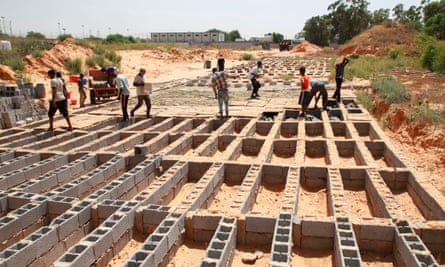One year on from the migrant detention centre bombing in Tajoura, eastern Tripoli, dozens of refugees and migrants who died have never been formally identified.
At least 53 people were killed and 130 injured on the night of 2 July 2019, according to the UN, after an airstrike by a foreign aircraft supporting eastern warlord Khalifa Haftar’s forces hit a hall where migrants and refugees were locked up.
Many of the victims had previously tried to reach Europe by crossing the Mediterranean Sea, but were caught and returned by the Libyan coastguard, which is supported by the European Union.
Dozens of the dead were buried in graves marked only with a serial number; according to aid workers, no attempts were made to contact their relatives. Though several were carrying identification, the only victim whose full name became public appears to be an Ethiopian woman who was named by local media as Najaax Cabdi Sugaale.
“When it comes to migrants it’s close to impossible here because most don’t have relatives in the country, they don’t have identification,” said an aid worker, on condition of anonymity. “So it becomes close to impossible to do any forensic response here. That was the case when this tragic incident happened last year. The authorities were not able to respond by the book, as most of the resources were not available [to them].”
“To my knowledge, nobody took charge of this,” said another source.
Survivors still in Libya planned to light candles, but were unable to properly mark the one-year anniversary on Thursday due to the coronavirus pandemic. Some sent messages to the Guardian asking for help. “We suffered a lot,” said one South Sudanese man. “We want to be out of this country in [a] safe place. We are not demanding specific countries or continents, but out of Libya.”
A report by the Tripoli-based Government of National Accord (GNA) – whose spokespeople did not respond to a request for an interview – described the aftermath of the bombing. “Upon entering the crime scene, we noticed the presence of human body parts, blood and debris spread in a chaotic way in the targeted location.”
The report listed the death toll as 37. At the time, fighters and militias associated with the GNA were fighting forces associated with Haftar and his self-styled Libyan National Army.
Survivors say the number of people who died was much higher, with at least 10 witnesses telling the Guardian they believe the death toll was above 100.

“It’s sad to think that lives were lost that day and a lot of those people, a lot of those faces, are going to remain anonymous,” said Safa Msehli, a spokesperson with the International Organization for Migration.
“We worked very closely with the Libyan Red Crescent and our staff, who were on location after the tragedy happened, were describing a horrific scene of body parts, faces disfigured … There’s no official registry of who is detained there [in Libya]. It leads to the wider issue of arbitrary arrests in Libya. There’s no clear process and no clarity on who is conducting these arrests and for what reason.”
Msehli said at least 40 survivors, including those injured, returned to the countries they originally came from after the bombing.
Tarik Argaz, a spokesperson for the UN refugee agency (UNHCR), said 58 survivors have since been moved to other countries: either Italy or to transit centres in Niger and Rwanda. Another 88 were due to be evacuated, he said, but that “was put on hold until the resumption of air traffic”.
Dozens more paid smugglers to cross the Mediterranean to Europe. At least two drowned, according to others who made the journey. One Sudanese man, now in France, said his asylum claim has already been rejected. “We thank God for our salvation from the hell of Libya and curse him for our fall in the hell of Europe,” he said.
